Pantex Blog
A smokin' good time
There was plenty of smoke and fire, but the Pantex firefighters weren’t responding to a four-alarm fire. They were cooking for the annual Amarillo Chamber of Commerce’s Good Times Celebration Barbeque Cook-Off. The Pantex team went up against 99 cook teams, smoking ribs, brisket and other meats, to see who had the best barbeque in town.
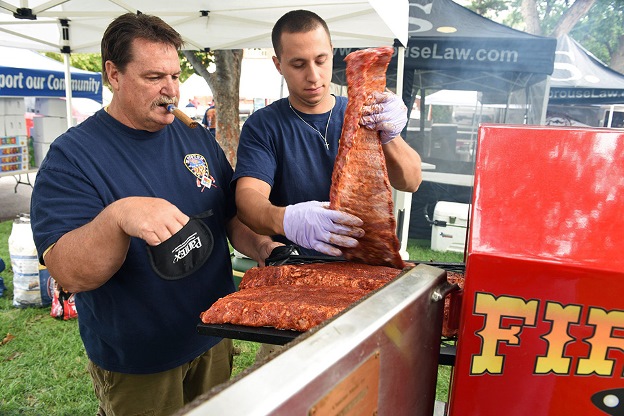
Scott Johnson, Pantex battalion fire chief (left) and Saxon Webster, firefighter/EMT, prepare ribs during the Amarillo Chamber of Commerce’s Good Times Celebration Barbeque Cook-Off. For the past 17 years, Pantex firefighters come together in September to smoke the best meats and enjoy the competition. (Photo courtesy of Michael Schumacher, Amarillo Globe-News)
The Good Times Celebration is in its 21st year, and for the past 17 years, Pantex firefighters come together for a couple of days in September to smoke the best meats and enjoy the competition. This year’s event took place Sept. 7 and 8. For some, it’s the group of co-workers that brings them to the barbeque.
“This is my first time to cook for the Chamber event, but I wanted to because of the guys out here on the cook team,” said Jeremy Baker, Pantex firefighter/paramedic. “I cook with them at the Boots vs. Badges event, and we have a great time each year.”
Not only were the Pantex firefighters serving up their best fixings to the judges, they were serving more than 6,000 people who lined the streets of downtown Amarillo for the event.
“When you watch a person bite into a rib, slice of brisket or a piece chicken and you get the eye roll along with the ‘yum’ sound effect, you feel good knowing what you worked at for hours has paid off,” said Scott Johnson, Pantex battalion fire chief.
Even though the team did not place in this year’s event, they are tweaking their recipes and will be back again next year.
“Amarillo is a unique community that’s always happy to come together for good causes and fellowship – often over great food. I love that so many Pantexans get engaged in this event each year, and a photo of our firefighters even made the front page of the newspaper. I was also happy to get to taste their amazing barbeque creations, as well as serve as a rib judge. As always, we are proud to be a member of this community, and I am very proud of all the Pantexans who took the time to volunteer,” said Michelle Reichert, CNS deputy enterprise manager.
Wild Pantex – Prairie dog boundaries
Article by Jim Ray, Pantex Wildlife Biologist/Scientist
Temperatures are moderating and although delayed frequently by muddy field conditions, we were finally able to finish the annual mapping of our colonies of black-tailed prairie dogs. Mapping is accomplished by driving the boundaries of the colonies—indicated by the area of clipped vegetation beyond the outer limit of visible burrows—in a vehicle equipped with GPS equipment. If areas within the colony appear unoccupied (grown-up vegetation and unmaintained burrows), we will “cut those areas out” as unoccupied. Mapping is an easier task during the wetter years because of a more noticeable difference in vegetation height between that occurring within the colony and vegetation occurring outside the boundary of the colony.
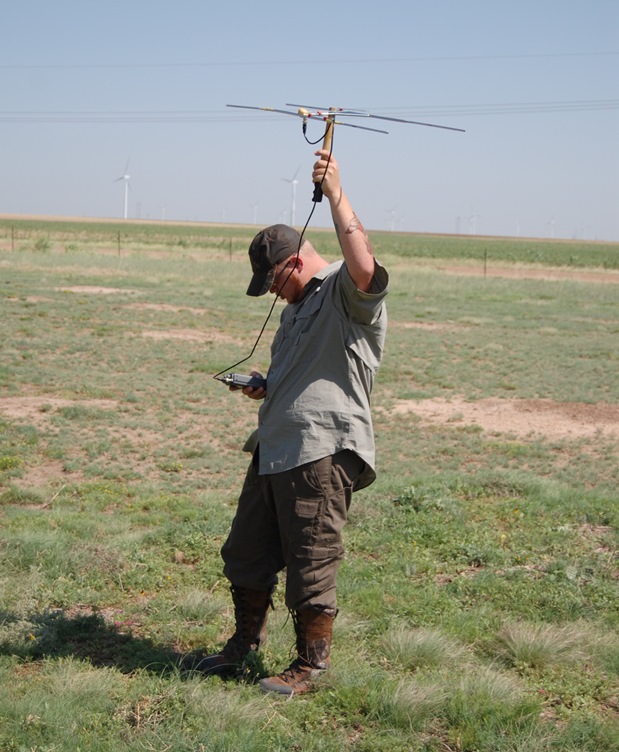
West Texas A&M University graduate Dustin Henderson attempts to locate a study animal in a prairie dog colony at the Pantex Plant.
Less widely-distributed on the site than most people would guestimate, the annual mapping we have conducted since 1997 has shown prairie dogs occupying an average of 357.5 acres. In addition, it is pretty obvious that our moderate cattle grazing rotation, along with moisture cycles, keeps prairie dog colony sizes largely in check. Annual variation in area occupied by prairie dogs over the past 12 years has ranged from -30 to 35 percent.
Besides wanting to monitor our prairie dog colonies as a resource, we also use the data for other purposes. For example, the value of colonies to other wildlife can be determined when compared to sighting and tracking data generated from other studies, like those we and collaborators have conducted on burrowing owls and other birds, amphibians and reptiles, small mammals (e.g., grasshopper mice), and bobcats.
Amount and timing of rainfall can have magical effects on the shortgrass prairie, including inside prairie dog colonies. 2015 was a “wet” year here in the Texas Panhandle, while this year was characterized by more modest rainfall distributed nicely through the year. In 2015, we noticed the diminutive plain’s milkweed (Asclepias pumila) and monarch caterpillars were unusually abundant in our prairie dog colonies, while this year antelope horn milkweed (A. asperula) seemed to be the benefactor of recent rainfall regimes. On our last day of mapping, I paused at a number of broadleaf milkweed plants (A. latifolia) and noticed many that hosted a monarch caterpillar.
I have never seen such a high number of burrowing owls in my 17 years of mapping compared to what I observed this year. The birds were everywhere and no doubt a product of good habitat and conditions for them and their insect, amphibian, reptilian, small mammal, and avian prey.
Whether it be an occasional stroll through a prairie dog colony or spending hours upon hours mapping their boundaries, I am always amazed at what all can be found in that habitat type. Remember, it’s always a best practice to use caution around prairie dog colonies.
Simply put, prairie dog colonies—having burrows, bare ground, different vegetation species and heights, and even unique animal communities—are important in terms of diversity to wildlife here in the shortgrass prairie.
Professional women for the WIN
For two women who represented Pantex and Y‑12 at the U.S. Women in Nuclear national conference in July, the organization lives up to its acronym — WIN — by offering win‑win benefits of professional development and networking.
Megan Houchin of Y‑12 and Evalita Perez-Bobb of Pantex participated in the national 2016 conference, “U.S. WIN: Building on the Promise of Nuclear Energy,” held in Charlotte, North Carolina. Houchin, whose job title is Lean Six Sigma Black Belt, is the president of the Oak Ridge WIN chapter. Perez‑Bobb, an electrical engineer who joined Pantex a year ago, is nearly as new as the recently formed Amarillo Pantex WIN Chapter, which is about eight months old.
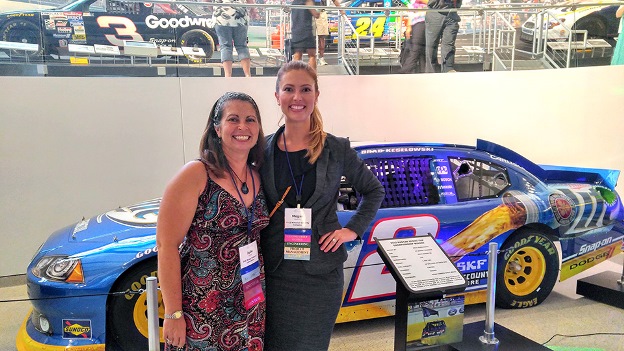
Y‑12’s Megan Houchin, right, enjoys a Women in Nuclear networking event at the NASCAR Hall of Fame in Charlotte, North Carolina. With her is Julie Ezold of the Oak Ridge National Laboratory.
U.S. WIN includes chapters from across the country, comprised of 8,000 women (and men) who work in nuclear and radiation‑related fields. The national organization is affiliated with WIN‑Global, an international organization in 100 countries.
“We do a lot of professional development. We call it womentoring,” Houchin said. “Most people think WIN is for nuclear engineers, but it’s not. It’s for anyone in the nuclear industry — which is everyone at Consolidated Nuclear Security.”
After joining Pantex about a year ago as an electrical engineer, Perez‑Bobb wondered if the organization offered peer networking like she experienced serving in the Navy. She was glad to hear that Pantex employees were establishing a WIN chapter.
Perez‑Bobb attended the conference as a last‑minute substitute and wasn’t sure what to expect. Walking into a panel discussion, she immediately recognized a familiar face and a connection to her naval service. Retired U.S. Navy Admiral Robert Willard, now president and CEO of the Institute of Nuclear Power Operations, was commanding officer of the USS Abraham Lincoln when she served on the aircraft carrier.
She said it was also amazing to see that two of the four panel speakers were women: Lynn Good, CEO of Duke Energy Corp., and Maria Korsnick, CEO of Nuclear Energy Institute.
“The women there were great, so inspirational. They were presidents, CEOs or top national experts in the nuclear energy field. I was grateful for being given the chance to socialize with so many women nuclear professionals in one place,” Perez-Bobb said.
Houchin had a similar experience as she chatted with a woman seated next to her at the lunch table, the president of one of the Savannah River Site operations.
Closer to home, the chapters meet monthly and often host guest speakers. Recent professional development topics include Facilitation 101 and networking. The chapters also take part in community outreach, such as Introduce a Girl to Engineering, and members speak at schools.
Weapon interns return as tomorrow’s leaders
Consolidated Nuclear Security (CNS) once again has two employees participating in the Sandia National Laboratories Weapon Intern Program (WIP): Tyler McClary, Mission Engineering, and Brandon Pehrson, Y‑12 Operations. This highly sought-after internship teaches the technical details of weapon systems and provides site interactions that provide a comprehensive picture of the Nuclear Security Enterprise. Following that education, the interns work on a project with enterprise and personal value.
Both are looking forward to being a member of the WIP Class of 2017. “I hope to use the knowledge I gain to better serve the needs of Pantex,” said McClary, who has been a Pantexan for almost five years and is a lead design engineer in Tooling & Tester Design.
Pehrson, a production specialist and Y‑12 employee for 11 years, said, “I want to learn more about the weapons parts and material function so I can understand impacts of changes. I also want to become an expert in the weapons field.”
Colby Yeary and Eva Irwin of Program Integration, the CNS contacts for the program, realize there are many advantages for having Pantex and Y‑12 representatives participate.
Yeary said, “Our representatives provide a perspective from two key production agencies in the Nuclear Security Enterprise. Tyler and Brandon’s perspectives, and those of past participants, offer production agency considerations that can be overlooked in important nuclear weapon product realization activities.”
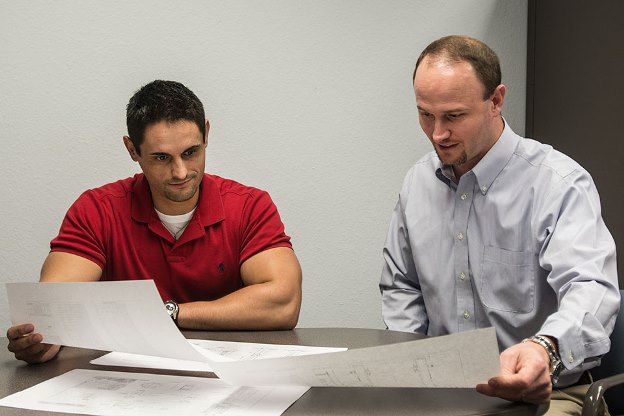
Tyler McClary (left) shares with Colby Yeary about participating in the WIP.
There are many benefits to the rigorous program. The first six months includes classroom work with site visits and research assignments. During the final five months, participants are embedded in various organizations across Sandia to work on specific projects.
“The interns are considered high potential and are able to develop and learn about the enterprise in an accelerated manner,” Yeary said. “It took me the better part of a decade to get the exposure and knowledge they will receive in less than a year.”
HaliAnne Crawford and Aaron Lee, the CNS representatives in the WIP Class of 2016B, offered advice to McClary and Pehrson. (During 2016, WIP had two classes.)
“No matter how daunting the next 11 months seem,” Lee said, “just jump in with both feet first as soon as possible. You have a limited time to learn as much as you can about a topic that is truly vast. Don’t waste a moment of the next 11 months because it will fly by.”
Crawford echoed Lee’s sentiment. “My advice is to get involved with the program, both inside and outside the classroom. Don’t be a passive participant. You will be learning from some of the greatest minds in our industry; ask questions and don’t be afraid to think outside the box.
“You will find that your classmates are some of the most brilliant individuals you will ever have the pleasure of working with,” Crawford said. “Get to know them, learn from their experiences and leverage their knowledge and abilities whenever possible. This year will be one of the best of your life. Enjoy every single second of it.”
Lee agreed: “Listen to your classmates. They will have just as much to teach you as the instructors do. Members of my class represented almost every other site within the NSE as well as NNSA and the military. They had knowledge and perspectives on certain topics that were completely different from my own due to their own different experiences. Everyone brought unique experiences to the program and had a lot of knowledge to share with the class.”
After the internship, WIP participants return to their respective sites to continue their leadership journeys. Yeary said, “The WIP prepares today’s workforce as tomorrow’s leaders by rapidly providing a holistic, yet reasonably detailed view of the nuclear weapons business. The program helps candidates connect dots to see the ‘big picture’ — an important attribute of senior leadership.”
Wild Pantex - Thinking Milkweed
Article by Jim Ray, Pantex Wildlife Biologist/Scientist
This August and September time frame has long been thought of as a special time by Pantex Agronomist, Monty Schoenhals, and myself. The reason is two-fold; these months are the peak time period when monarch butterflies are drifting through the region and when an abundance of milkweeds are in bloom and hosting an impressive number of monarch caterpillars. We have our own interest in the monarch’s use of this 18,000-acre federal facility and the Texas Panhandle as a whole, but we also now have justification to study and protect the monarch and the habitats that it and other pollinators so desperately need for survival. The White House Pollinator Initiative was announced in early 2014, and we have busied ourselves with mapping colonies of milkweed, documenting caterpillars, proposing research, and, although unsuccessful so far, we are applying for grants.
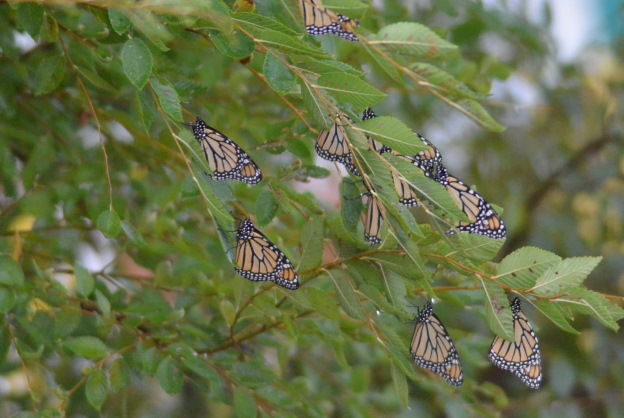
Migrating monarch butterflies cluster on elm trees after resting through the night at Pantex.
Our current philosophies are to manage for and protect wildflowers through sound range management and adjusted mowing practices, have a strong focus on milkweeds, and monitor monarch production on the site. We are excited that we find an abundance of milkweeds including six species, 1) antelope-horns (Asclepias asperula), 2) broad-leaf (A. latafolia), 3) Engelmann’s (A. engelmanniana), 4) horsetail (A. subverticillata), 5) plains (A. pumila), and 6) whorled (A. verticillata) milkweed! Go out and locate a colony of horsetail, plains or whorled milkweed right now, and you will see monarchs visiting for nectar and possibly laying eggs.
Time will only tell if the monarch butterfly can rebound from historically low populations, but we can certainly do our part here at Pantex and even in backyards across this nation. Study up on native plants that are important to our native pollinators. Protect the ones in our landscapes and plant them on your properties. Now is a particularly good time to protect and plant milkweeds. See which ones should be in your area and search for seed for those species. At a minimum, migrating monarchs will need nectar sources, and many will lay eggs on milkweeds in order to produce that next generation that has a better chance of reaching points south on their journey to their wintering sites in Mexico. We here at Pantex hope that we are able to contribute to that great cause.

A monarch caterpillar feeding on horsetail milkweed at the Pantex Plant in 2015
